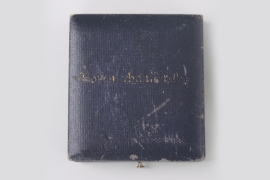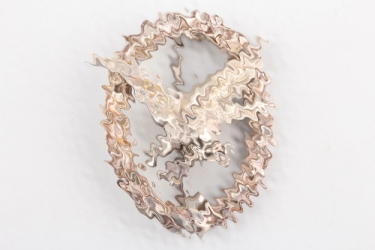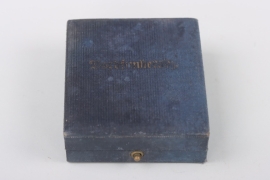Air Gunner & Flight Engineer Badge with Lightning Bolts
Militaria Price Guide
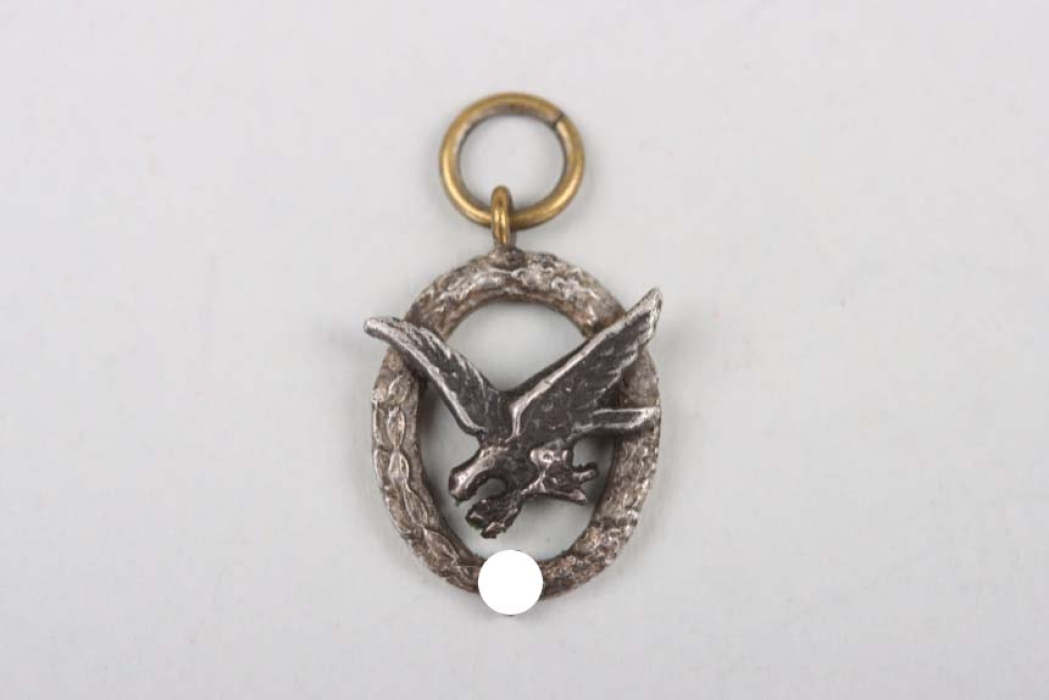
Air Gunner & Flight Engineer Badge with Lightning Bolts miniature
MILITARIA PRICE GUIDE
How can I see prices?
Welcome to the ratisbon's MILITARIA PRICE GUIDE!
To access all prices, pictures, and descriptions please subscribe to our MILITARIA PRICE GUIDE at www.ratisbons.com/militaria-price-guide. Save 25% when subscribing for one year! Get full access for just 75€!
We are buying single items and entire collections! Call +49 8541 9053699
-
PAYMENT
-
HOW CAN I PAY FOR MY ORDER?
AUCTIONSYou will receive an e-mail confirming your successful bids the day after the auction has ended. In your personal my ratisbon's you will be able to inform us about your most convenient payment method for this order or tell us about an alternative shipping address.
If we don’t hear from you within 24 hours, we will send an invoice choosing the payment and shipping options which we think are the most comfortable ones to you. If you decide to change your shipping or payment method after receiving your invoice, just drop us a line or visit my ratisbon's/ORDERS for any more details.
SHOP ORDERSChoose your payment method when ordering and submit your order. Once your order has been received we will send an invoice including your shipping costs and your payment instructions.
After receiving the invoice, the order must be paid within 7 days.
Please contact us to discuss layaway options.To learn more about paying at ratisbon's, please see your FAQ pages.
WE ACCEPT FOLLOWING PAYMENT METHODS
-
-
Versand
-
HOW DO YOU SHIP MY NEW TREASURES?
PACKING & TRACKINGWe usually send out orders within 1-3 working days after your payment has been received. In most cases, we are faster than this! We will inform you when your goods are being dispatched and provide a tracking number, In addition, you can always check your order status at my ratisbon's/ORDERS. Delivery times will vary depending upon the delivery destination and type of shipping service you have chosen.
SHIPPING TO ALTERNATIVE ADDRESSIf you prefer to have your order shipped to your work address or a friend during your absence, we will happy to arrange this for you. Send us an email letting us know about your new shipping address and we will be happy to send an updated invoice to you.
OUR LOGISTIC PARTNERS ARE AS FOLLOWS
-
-
OUR GUARANTEE
-
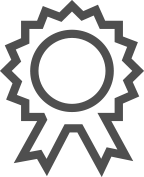 OUR GUARANTEE!
OUR GUARANTEE!We only offer collectables which to the best of our specialists knowledge are authentic. About 15% of all consignments are returned to the consignor after extensive research due to authenticity issues.
Unlike traditional auction houses we do offer a full right of return. If you are not satisfied with what you won or bought, you may return it within 14 days. Please inform us and we will instruct you on how to return the goods. For more information, please visit FAQ pages.
Important note: Cancelling bids after an auction may disappoint the consignor, who like you is a collector. This situation is easy to avoid. We encourage you not to bid on any collectable if you are unsure if it fits into your collection. Ask us to cancel your bid 24 hours prior to the end of an auction to avoid this situation.
-
COUNTRY Germany 1918 - 1945
DIMENSIONS
WEIGHT
EAN 2000000753058
PERIOD 1918 — 1945
COUNTRY Germany 1918 - 1945
COUNTRY Germany 1918 - 1945
LOT 67-1094
Air Gunner & Flight Engineer Badge with Lightning Bolts
Description
Air Gunner & Flight Engineer Badge with Lightning Bolts. 16 miniature. For the so-called "Frackkettchen".
Condition
2
The publication dated on May 27 1935, from the Luftwaffenverordnungsblatt, gives information and details from the January 19 1935 decree ; the eagle holding firmly the lightning bolts between his claws was added to the oak and laurel leaves in which will now be established as the main striking design of this award. The Radio Operator and Air Gunner Badges (RO/AG) were the last flight badges to be officicially found and were officially described and published by the Reichminister der Luftfahrt on November 27 1935.
With the new growing Luftwaffe and later with the expansion of the war efforts the high demand for a wider range of specializations for Air Gunner, Radio Operator and Flight Engineer was not just a glimps but a constant reality. The later air gunners had to follow a smiliar path from the pilot training. They started with the initial six months of training at the Kriegschule or Fliegereresatzabteilung ; learning the basic of military life, intense physical training, general basic radio communications, survival notion, recognition, weaponery and more. After the mandatory intitial training, candidates were then sent to their chosen armed of service at one of the several Luftwaffe specialized Schools. The Air Gunners (Bordschützen) were sent to the Fliegerschützenschule (Air Gunner School) that was later re- named, in Januray 1942, Bordschützenschule after the decree that separate all three service of arm that used to be under the same award badge. The Flight engineers (Bordmechaniker) were sent to the Fliegertechnischeschule (Aviation Technical School) and the the radio operators (Bordfunker) were sent to the Luftnachrichtenschule (Air Signal School). From there, the new trainee candidates would receive specialized theorical and physical learning and teaching in each corresponding intended career for these three armed of service.
BORDFUNKER
The German Luftwaffe relied and depended on an increasingly diverse array of electronic communications and equipments and for this reason the trainee radio operator or for some, the wireless operator (Bordfunker), were required to meet with set standards and succeed in a very intensive and demanding nine month course at the air signal school (Luftnachrichtenschule). The basic initial training was carried out along with other Luftwaffe personal that also required radio operator training such as futur pilots or flak fire controllers etc... The course consisted of a deep studying of the reception and transmiting of morse code, radio frequencies, the differences and uses of the radio spectrum and their fonctionalities, designed emergencies and reserved frequencies etc. The fonctionning of the equipments and their maintenance was also carried out. A later course was taken to master both theorical and hands on radio navigation and radio instrumentations. This course section was performed at a separate school were real flights were disptached and later directly placed into Luftwaffe units in real situations.
BORDSCHÜTZEN
The futur new Luftwaffe air gunner trainee entered into a very rigourous five month of extensive gunnery course and markmanship abilities. The large range of weapons used during his training was to familiarize the gunner from small arms like Mauser Riffle or 9mm Pistol to different machine guns (MG series). Learning how to aim and lead a target was teached on a riffle before going on to machine guns. They spent days in a shooting range to practice precision and were taught data about handguns and machine guns. They also learned how to perform maintenance and proper cleaning, how to tear down and reassemble the guns, how to load drums and ammunition belts. All these skills needed to be memorized and a very rigourous exam was performed at the end. During that training period, their time was spent around disassembling and reassembling their machine guns according to manufacturing and military procedures. They had to be able to dismantle the MG to every single removable piece or up to the malfunction to be fix and then of course reassembled it in a certain amount of time. These exercises needed to be done repetitively until a perfect masterization was attained to ensure all trainees could clear as quickly as possible a machine gun jam or malfunction. These exercises had to be completed with full gear and gloves on and even blindfolded, to mimic real combat conditions.
BORDMECHANIKER
The flight engineer has the responsability to keep the aircraft airborn and combat ready at all time. The requirement was ascomplished at the Fliegertechnischeschule (Aviator Technical School). The training lasted a nine months period, in which time, they received theory and practical engineering about various aircraft systems such as : engines, electronics, flight control, weaponery, hydraulics, elementary aerodynamics and many more. At the end of the engineering course, the trainees were then sent to plane manufactories or directly to military maintenance units as a stage to put into pratice what was taught and to gain practial experience. With the very wide range of different technology from injection engine to the jet engine at the end of the war, the flight engineer was, in general, assigned to only one or few types of airplanes. Later on the war, with the growing demand, the flight engineers were requested to work on several technologies simultaneously.
FLIEGERSCHÜTZENABZEICHEN OHNE BLITZBÜNDEL
A new regulation, from the decree of the 22 June 1942, issued by the Reichminister der Luftfahrt was made to separate the Radio Operator from the Air Gunner and the Flight Engineer and created an independent award for each. The five month training had change considerably and more rigourous with exclusively and specific training which concentrate specifically to the position intended. Also, the new weaponery and new technic that followed the war efforts were taught together which resulted to crews being more knowledgeable and experienced for combat situations. The Fliegerschützenabzeichen ohne Blitzbündel badge was under the same decree that stipulated it could be awarded without the completion of the initial training if a crew member had participated in a minimum of five missions or wounded in flight. The Radio Operator, Air Gunner and Flight Engineer were all awarded under the same badge design with the eagle clutching two lightning bolts. After the decree of the 22nd of June 1942, all manufacture stock badges and every men previously qualified as an air gunner or a flight engineer had to remove the lightning bolts from their RO/AG award as it would not be replaced. The result gave a very nice quality looking badge and are known in the community under the name CO/AG, that stands for Cut Off Air Gunner Badge.
For more information on the Radio Operator, Air Gunner and Flight Engineer Badges, we gladly refer the interested collector to the reference work “The German Luftwaffe Radio Operator, Air Gunner and Flight Engineer Badges of WWII 1935-1945“ written by Sébastien Talbot and Stephan Papke.





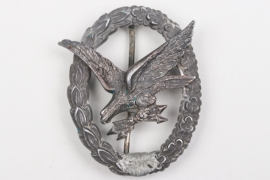




.jpg)






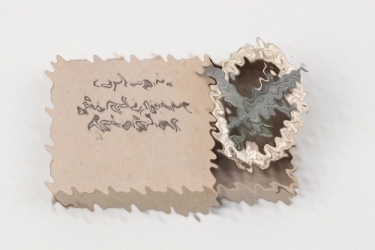


.jpg)
